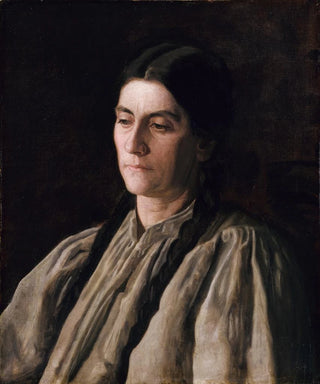Art print | Mother Annie Williams Gandy - Thomas Eakins Source: Reproduction | Mère Annie Williams Gandy - Thomas Eakins


View from behind

Frame (optional)
Thomas Eakins's artwork "Mother Annie Williams Gandy" serves as a window into the intimacy and depth of human relationships. An emblematic painter of 19th-century American art, Eakins manages to capture not only the physical resemblance of his subjects but also their inner essence. In this piece, the mother's gaze, imbued with tenderness and strength, evokes universal emotions such as unconditional love and resilience. The art print of this work invites immersive contemplation, allowing the viewer to immerse themselves in a frozen moment in time, where each brushstroke tells a story.
Style and uniqueness of the work
Thomas Eakins's style is distinguished by its striking realism and meticulous attention to detail. In "Mother Annie Williams Gandy," light plays a crucial role, illuminating the mother's face with a delicacy that highlights the nuances of her expression. Colors are chosen carefully, creating a warm atmosphere that envelops the viewer. Eakins does not merely reproduce reality; he interprets it with a sensitivity that transcends simple portraiture. Every element of the composition, from the folds of the clothing to the facial features, demonstrates technical mastery and a deep understanding of human nature. This work, with its apparent simplicity, reveals an emotional complexity that cannot leave one indifferent.
The artist and his influence
Thomas Eakins, born in Philadelphia in 1844, is often regarded as one of the pioneers of realism in painting. His academic training, enriched by travels in Europe, allowed him to refine his artistic approach, blending tradition and innovation. Eakins established himself in the American art scene by highlighting often neglected subjects, such as portraits of women and children, while incorporating themes related to science and medicine. His influence extends far beyond his era, inspiring many contemporary and future artists who sought to explore the relationship between art and reality. In "Mother Annie Williams Gandy," we find this desire to capture the authenticity of human emotions, a legacy that Eakins left.

Matte finish

View from behind

Frame (optional)
Thomas Eakins's artwork "Mother Annie Williams Gandy" serves as a window into the intimacy and depth of human relationships. An emblematic painter of 19th-century American art, Eakins manages to capture not only the physical resemblance of his subjects but also their inner essence. In this piece, the mother's gaze, imbued with tenderness and strength, evokes universal emotions such as unconditional love and resilience. The art print of this work invites immersive contemplation, allowing the viewer to immerse themselves in a frozen moment in time, where each brushstroke tells a story.
Style and uniqueness of the work
Thomas Eakins's style is distinguished by its striking realism and meticulous attention to detail. In "Mother Annie Williams Gandy," light plays a crucial role, illuminating the mother's face with a delicacy that highlights the nuances of her expression. Colors are chosen carefully, creating a warm atmosphere that envelops the viewer. Eakins does not merely reproduce reality; he interprets it with a sensitivity that transcends simple portraiture. Every element of the composition, from the folds of the clothing to the facial features, demonstrates technical mastery and a deep understanding of human nature. This work, with its apparent simplicity, reveals an emotional complexity that cannot leave one indifferent.
The artist and his influence
Thomas Eakins, born in Philadelphia in 1844, is often regarded as one of the pioneers of realism in painting. His academic training, enriched by travels in Europe, allowed him to refine his artistic approach, blending tradition and innovation. Eakins established himself in the American art scene by highlighting often neglected subjects, such as portraits of women and children, while incorporating themes related to science and medicine. His influence extends far beyond his era, inspiring many contemporary and future artists who sought to explore the relationship between art and reality. In "Mother Annie Williams Gandy," we find this desire to capture the authenticity of human emotions, a legacy that Eakins left.






